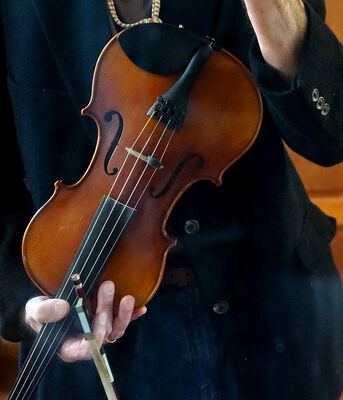Going Manual all the Way
Mar 22, 2017 15:25:20 #
amfoto1
Loc: San Jose, Calif. USA
speters wrote:
That's the way I always start with a new camera... I set it to manual and start shooting, once I'm somewhat familiar with the camera I try some of the auto setting too. That's the way I've always done this!
Why? The labels might vary a little, but all cameras have pretty much the same M, A or Av, S or Tv, and P or Program modes.
Any variations are due to the way the metering system is calibrated and works. Even with those, the difference are usually pretty slight... Most cameras today offer some "intelligent" form of metering now (Canon "Evaluative", Nikon "Matrix", Pentax and Sony "Multi-Segment" or Olympus "ESP"), as well as "old school" style Center Weighted, and often Partial or even Spot Metering patterns. Most also offer some form of Exposure Compensation and AE Lock, as means of overriding the auto exposure modes. The exact labels and controls used to access the modes and metering methods may differ from model to model and brand to brand... but the functions are pretty much the same.
In fact, these exposure modes are universal enough (since the late 1970s) that folks like Bryan Peterson can write books such as his "Understanding Exposure", which is applicable to the vast majority of DSLR and more advanced mirrorless, "bridge" or P&S cameras being offered today.
The more highly automated "Scene" type modes are another matter (and personally I never use them... just as I don't use White Balance presets or auto focus "Cases"... all of which are someone else's idea of how a camera and lens should be set up to do a particular type of shot under certain conditions).
Mar 22, 2017 16:54:35 #
PGHphoto
Loc: Pittsburgh, PA
Brasspounder001 wrote:
You can shoot manual on a DSLR, but it's still not... (show quote)
I find that staying primarily on manual allows me to more easily identify (when I have to use an auto mode) that the camera is not seeing things like I am. The classic underexposure scenario of a white subject with a white background is easier to spot when you are aware of the lighting conditions and have a feel for what the exposure should be. I can see through the viewfinder that the selected exposure is probably wrong and, if I want to stay in an auto mode, I can quickly use the exposure comp to dial in something closer to what I need.
I also focus using backbutton focus and spot meter with exposure lock most of the time when in an auto or semi-auto mode. Unless I am in an extreme run-and-gun situation then I am thankful for the camera's full auto capabilities.
I think that everyone buying a DSLR should be required to shoot 24 exposure rolls of 35mm film for at least 6 months before they can get a DSLR ! But that would lock out people like my mom who prefer the soft focusing and overdeveloped look of Polaroids because they can get the shot right now ! I don't think everybody should conform to my version of what they should like (even though it would be better for them !!!! ;-} ) . I only react with disdain to those who complain that they can't duplicate what I do with the same camera and yet still refuse to get out of full auto.
Mar 22, 2017 17:40:55 #
Rloren wrote:
Like I tell my wife, my smart phone is a computer ... (show quote)
FWIW, back in the film days when I shot mostly people and mostly in controlled lighting I shot fully manual ( W/ NO light meter) and was quite adept at it.
Today I shoot mostly wildlife in un-controlled lighting situations for the most part and use manual with auto ISO and use EX Comp regularly ( I am on Sony with EVF - so I can actually SEE what I am gettting before I get it ). On RARE occasions with constant light and shooting birds (when the sky is cloudless or overcast and no big shade trees around) I will go to FULLY manual including ISO.
Mar 22, 2017 18:14:27 #
SteveR wrote:
I'm sorry, but if you're shooting auto ISO, you're... (show quote)
I'm not that advanced yet. In the old days with SLR I would select either the aperture or shutter speed I wanted and rely on the built in meter to tell me the other setting. Now I can set both shutter and aperture and rely on the camera to set the film speed, as it were. At the moment I'm quite happy with that.
Mar 22, 2017 18:43:16 #
I always shoot manual or aperture priority, and couldn't get any more automated even if I wanted to (I don't want to) because aperture priority is the only automation my camera has. Autofocus? Nope, don't have or want it. I can't even review the image when I'm done because I don't have a screen.
While I do shoot film, it is my digital camera that I'm describing above. Leica M-D 262, digital rangefinder with no LCD, no JPG mode, no autofocus, no automatic aperture, just manual or aperture priority and a simple center-weighted meter. It won't even do auto-ISO, just has a big manual ISO dial on the back with 1/3 stop settings between ISO 200 and ISO 6400, with 3200 being the ceiling for color and 6400 still beautiful for black and white. Its the perfect digital counterpart to my 45-year-old Leica M5.
No zoom lenses either, just a 35mm, a few different 50mms and a 90mm; everything I want or need.
While I do shoot film, it is my digital camera that I'm describing above. Leica M-D 262, digital rangefinder with no LCD, no JPG mode, no autofocus, no automatic aperture, just manual or aperture priority and a simple center-weighted meter. It won't even do auto-ISO, just has a big manual ISO dial on the back with 1/3 stop settings between ISO 200 and ISO 6400, with 3200 being the ceiling for color and 6400 still beautiful for black and white. Its the perfect digital counterpart to my 45-year-old Leica M5.
No zoom lenses either, just a 35mm, a few different 50mms and a 90mm; everything I want or need.
Mar 22, 2017 18:53:37 #
When I started taking photos, circa 1960's, all we had was manual. Sure, there were light meters, but after a while from lots of trial and error, you would know what setting you needed by the light of the day.
Mar 22, 2017 18:59:28 #
Think ahead about the shot and select the setting. Including using the "modes" in certain cases.
Biased to shoot exclusively manual as the camera almost never gives me the shot I visualize....same with ETTL flash..
Exceptions:
1) video : F8 - turn off AF and set the ISO.
2) "Must have, no time to think, miss the shot and you will be killed" - Aperature priority, auto ISO with min shutter speed set in camera and then programmed into C1.
For #2 example: backing out of the church snapping the B&G exiting and not adjusting exposure....key first couple shots blown out as soon as we got outside...Flip to C1 and dont worry :-)
Biased to shoot exclusively manual as the camera almost never gives me the shot I visualize....same with ETTL flash..
Exceptions:
1) video : F8 - turn off AF and set the ISO.
2) "Must have, no time to think, miss the shot and you will be killed" - Aperature priority, auto ISO with min shutter speed set in camera and then programmed into C1.
For #2 example: backing out of the church snapping the B&G exiting and not adjusting exposure....key first couple shots blown out as soon as we got outside...Flip to C1 and dont worry :-)
Mar 22, 2017 19:20:46 #
amfoto1 wrote:
No, a light meter really isn't a computer... it's just an accurate sensor with a precision readout.
The "computer" is located a few inches behind the camera... It's the photographer's brain.
The "computer" is located a few inches behind the camera... It's the photographer's brain.
I was being sarcastic but you are very right
Mar 22, 2017 19:50:16 #
I use most features and I include Photoshop Elements as a feature. I'm learning a new camera (Lumix) so things don't come out as I necessarily wanted.
Mar 22, 2017 21:04:21 #
Mar 22, 2017 23:35:56 #
Architect1776 wrote:
Of course. But what about the T,what does it stand for?
A Canon rep at a PPA convention told me:
P=Poor
A=Awful (Av=Awfully variable)
S=$#!t (Tv=Terribly variable)
M=Make Money Mode
iA=iffy Auto
It's not true, but it has a certain ring of truth in it!
Mar 22, 2017 23:46:01 #
Texcaster wrote:
I'm not that advanced yet. In the old days with SLR I would select either the aperture or shutter speed I wanted and rely on the built in meter to tell me the other setting. Now I can set both shutter and aperture and rely on the camera to set the film speed, as it were. At the moment I'm quite happy with that.
Tex...In film days, the first thing that you selected was your ASA with your choice of film. The next thing you selected was either your aperture or shutter speed after which you selected the other component of exposure based upon what your meter told you. So...you were shooting totally in manual. You can't consider that you are shooting totally in manual with your digital camera until you pre-select your ISO, then select either aperture or shutter speed and then select the other component based upon what your meter tells you. The nice thing about digital, however, is that if the aperture and shutter speeds that you're trying to use don't work you can always adjust the ISO. You don't have to remove the film and put in faster film.
Mar 22, 2017 23:52:41 #
SteveR wrote:
Tex...In film days, the first thing that you selec... (show quote)
Most of my digital cameras had an auto ISO feature, but I've never used it. ISO is just another variable that gives creative options and limitations. Its nice to be able to stop action, have ample depth of field in poor lighting, but that comes at the cost of noise. Likewise its great to be able to have narrow depth of field even in bright light, which of course makes motion blur impossible (without a very strong ND filter). I learned exposure back in the film days, so while I love being able to change films with the press of a button or twist of a dial, like aperture its just not something I'm willing to let the camera do for me. As for shutter speed, meh, unless I really want to stop or blur motion I tend to just let it fall where it may so long as its fast-enough to hand-hold.
Mar 23, 2017 00:14:28 #
It's a good way to learn about what you are doing. Afterwards you can use the various features with much more knowledge and convenience.
Mar 23, 2017 10:16:45 #
If you want to reply, then register here. Registration is free and your account is created instantly, so you can post right away.










